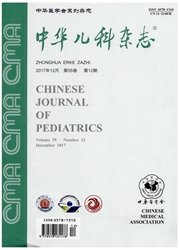

 中文摘要:
中文摘要:
目的探讨乙型肝炎病毒(HBV)s基因的突变在乙型肝炎病毒相关性肾炎(HBV—GN)发病中的意义。方法从53例患儿(30例HBV—GN,5例。肾病伴HBV携带者,18例HBV携带者)的血清中提取DNA,以聚合酶链反应技术对HBV—DNA的S基因进行扩增,然后对扩增产物进行测序。结果(1)53例患儿血清型中52例为adw,在HBV携带组中1例为adr。(2)HBV基因型分型:30例HBV—GN中29例为B型,1例为E型;5例肾病HBV携带患儿为B型;18例HBV携带患儿中17例为B型,1例为c型。(3)30例HBV—GN中21例(70%)有点突变,共计17种突变,11种为错义突变,6种同义突变。16例(16/21,76.2%)点突变导致S抗原中氨基酸取代,其中11例(11/16,68.8%)涉及丝氨酸、苏氨酸、酪氨酸等潜在促分裂素原活化蛋白激酶(MAPK)和蛋白酪氨酸激酶(PTK)的磷酸化位点。5例。肾病伴HBV携带者中2例有同义突变,3例无任何突变;18例HBV携带者共有3例同义突变,无氨基酸改变。结论HBV—GN患儿大多存在HBVS基因变异并导致s抗原中氨基酸取代,其中主要涉及丝氨酸、苏氨酸、酪氨酸等MAPK和PTK的磷酸化位点,这些重要位点氨基酸的取代可能在HBV—GN的发病中起作用。
 英文摘要:
英文摘要:
Objective Hepatitis B virus-associated glomerulonephritis (HBV-GN) is an immune complex-mediated glomerulonephritis. The present study was conducted to identify HBV S gene mutation in children with HBV-GN. Methods Serum HBV DNA was extracted in 53 children, including 30 with HBV- GN, 5 with HBV-carring nephrosis ( control group 1 ), and 18 HBV carriers ( control group 2 ). HBV S gene sequence was amplified by polymerase chain reaction (PCR). The PCR products were sequenced directly and compared with AY167097.1, an epidemic HBV strain in China. Results ( 1 ) The adw serotype of HBV was found in all the 30 cases with HBV-GN, 5 cases with HBV-carrying nephrosis and 17 HBV carriers except for 1, in whom adr serotype was identified. ( 2 ) HBV genotype B was found in 29 children with HBV- GN, 5 cases with HBV-carrying nephrosis and 17 HBV carriers, genotype E was found in a child with HBV- GN, and genotype C in an HBV carrier. (3) A total of 17 kinds of different single nucleotide change in HBV S gene were identified in 21 of 30 ( 70% ) HBV-GN patients. Among them, 16 of 21 ( 76. 2% ) nucleotide mutations resulted in amino acid substitution. It was interesting that most (11/16, 68.8% ) amino acid substitutions involved threonine, serine and tyrosine, the potential phosphorilation sites of mitogen-activated protein kinase (MAPK) and protein tyrosine kinase (PTK) in HBV protein. Single nucleotide changes which didn not result in amino acid substitution were found in 2 HBV-carrying nephrosis patients, 2 HBV carriers and 5 cases with HBV-GN. Conclusion Single nucleotide changes in HBV S gene were found in most children with HBV-GN. Most mutations in HBsAg resulted in amino acid substitutions involving threonine, serine and tyrosine, which may play a role in the pathogenesis of HBV-GN.
 同期刊论文项目
同期刊论文项目
 同项目期刊论文
同项目期刊论文
 期刊信息
期刊信息
